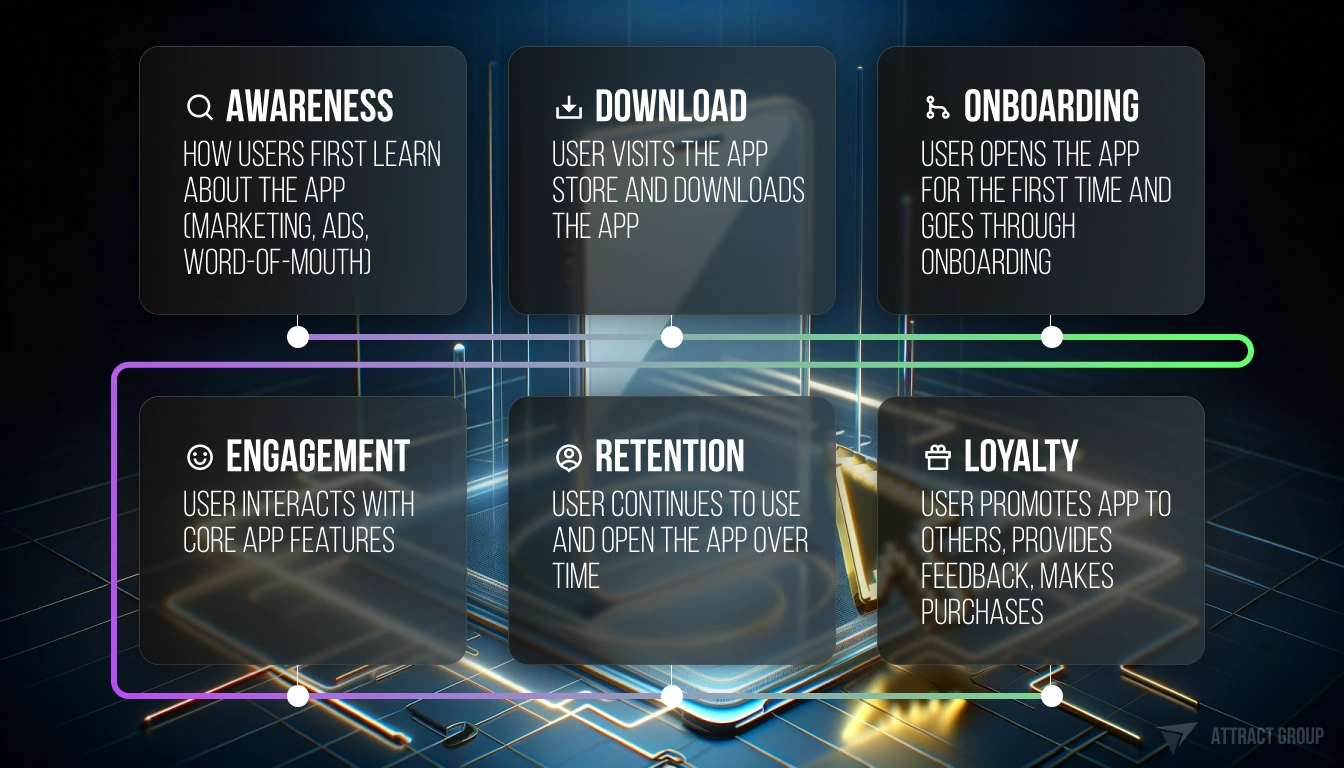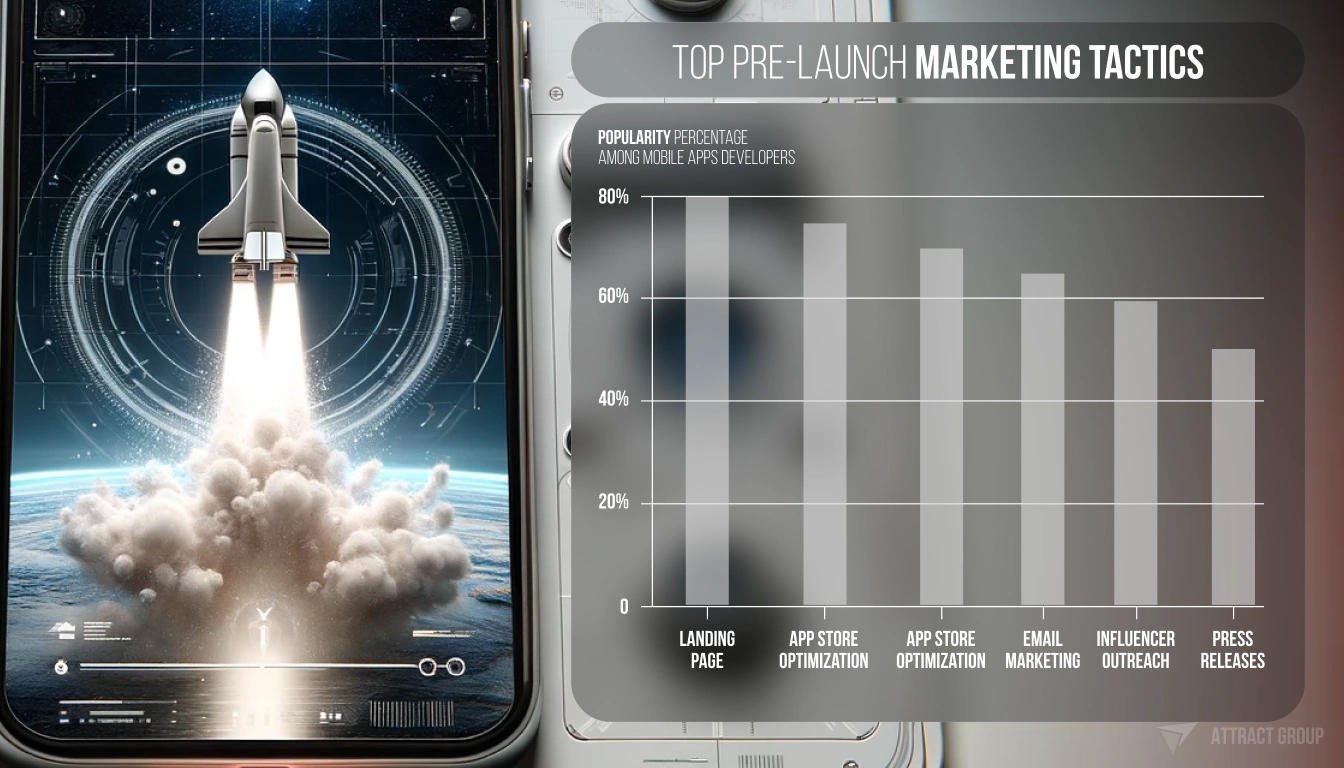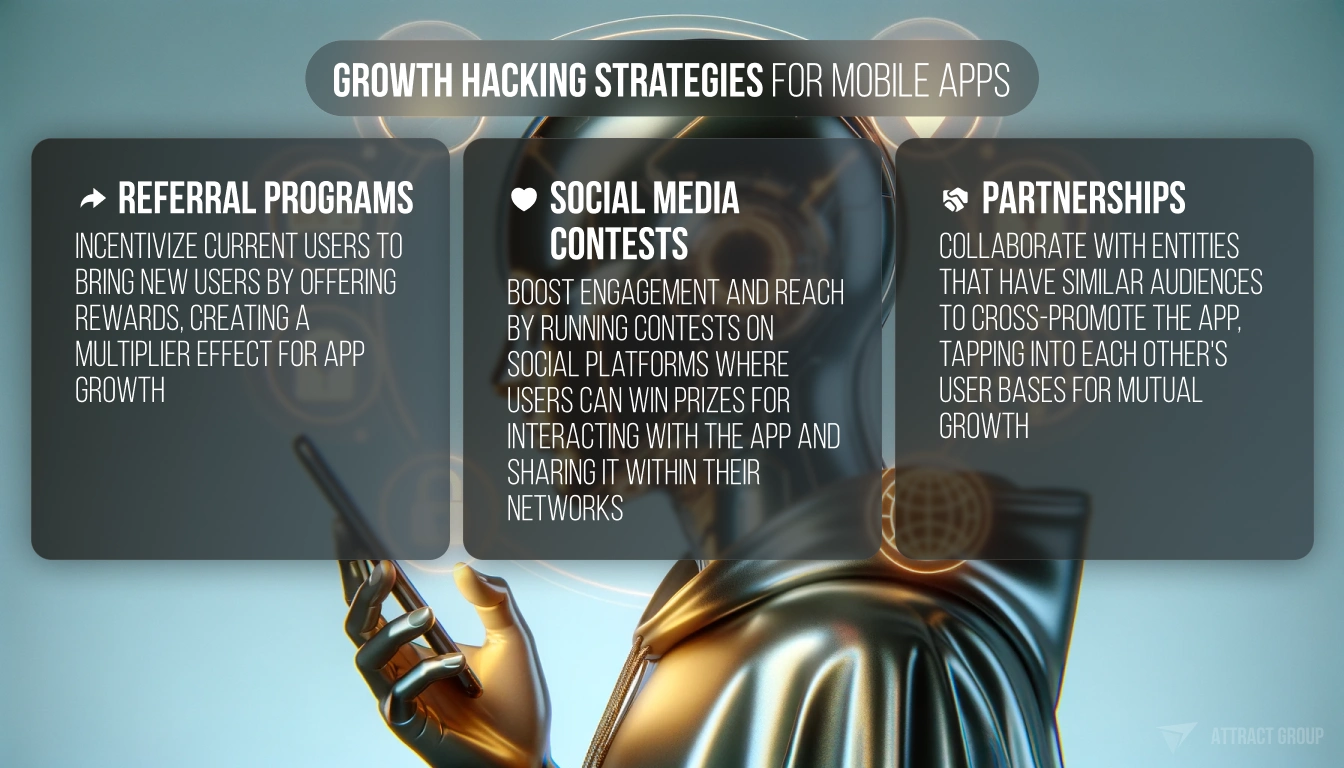App Marketing Guide: Mastering Mobile Application Marketing Strategies
 21 November 2023
21 November 2023With millions of apps vying for attention, a strategic marketing plan is not just beneficial; it’s essential for survival and success. It’s the force that propels your app from obscurity to prominence, transforming it from an overlooked icon into a staple on users’ devices.
The journey of mobile app marketing is divided into two critical phases: pre-launch and post-launch. Each stage comes with its own set of strategies, challenges, and goals. The pre-launch phase is about laying the groundwork, creating anticipation, and ensuring that you hit the ground running. It’s during this phase that you define your brand identity, understand your target audience, and start the buzz that will carry through to your launch.
Once your app is live, the post-launch strategies take the helm. This is where the focus shifts to acquiring users, measuring performance, and iteratively improving the app. It’s about maintaining the momentum and leveraging user feedback to keep your app evolving and growing.

In this guide, we’ll take a comprehensive look at the marketing tactics that can make or break your app’s success. From ASO to user engagement, we’ll provide a blueprint for the entire marketing lifecycle of your app. Prepare to dive into the dynamic world of mobile app marketing, where every decision and every strategy can turn the tides of your app’s journey.
Crafting a Pre-Launch Mobile App Marketing Strategy
An effective pre-launch strategy primes the market for your app, creating an air of anticipation and laying the foundation for its future success. This phase is crucial for building awareness and setting you up for a successful launch.
Market Research and Target Audience Identification
First and foremost, a deep understanding of your market and audience is critical. This involves comprehensive market research, identifying who your potential users are, what they need, and how your app can fulfill that need. Through surveys, user interviews, and competitive analysis, you gather valuable insights that shape your product development and marketing strategy.
Knowing your audience is the first step to creating an app that resonates. As Steve Jobs once said, ‘You’ve got to start with the customer experience and work backward to the technology.
-Steve Jobs 1997
Branding and Value Proposition
Crafting your app’s identity involves more than picking a catchy name; it’s about creating a brand that resonates with your target audience. Your value proposition should clearly articulate the unique benefits of your app and why it’s the preferred choice for users. This message needs to be consistent across all your marketing materials and touchpoints with potential users.
Pre-Launch Marketing Tactics
Generating buzz before the app hits the market is essential for a successful launch. This means initiating marketing activities that capture the interest of your target audience and industry influencers.
Building a comprehensive email marketing campaign is a good start. It allows you to nurture leads by sharing updates, milestones, and teasers about your app. Content marketing can also play a significant role in this stage. Create engaging content that highlights the value of your app and addresses user pain points, which can be shared across your digital channels.
Building Hype Pre-Launch
Crafting an impactful landing page is a pivotal step in the mobile app marketing strategies playbook. This digital storefront is where you make your first impression count, not just to enlighten but also to entice visitors into becoming early adopters of your new app. It’s essential that the landing page crystallizes your app’s utility and presents a clear user journey, coupled with a compelling call to action—whether that’s to secure early access or to subscribe to updates.
Your app marketing plan should leverage social media platforms as a loudspeaker to amplify your mobile engagement loop. These platforms serve as arenas to interact with potential app users, disseminating content, fostering a community, and elevating awareness of your app. Customizing your message for each platform, you can spark dialogue, field inquiries, and generate excitement.
Embracing influencer and partnership marketing is a dynamic addition to your acquisition strategy. Collaborations with influencers and allied brands can catapult your app into the limelight, driving app downloads. These partnerships must be curated with intent, fostering authentic advocacy that resonates with your intended mobile app user base and contributes to the success of your app.

Building Hype Pre-Launch Your Mobile App
Creating excitement for your app before it officially launches is a vital component of your marketing strategy. The goal is to have a captivated audience eagerly awaiting its release.
Creating a Landing Page
Your app’s landing page is the central hub for your pre-launch efforts. It should not only be visually appealing but also convey the core benefits of your app succinctly. The landing page must include:
- A strong headline that captures attention and communicates the app’s value.
- Engaging content that teases the app’s features and benefits, encouraging visitors to learn more.
- A clear and compelling call to action (CTA), such as ‘Sign Up for Early Access’ or ‘Join the Waitlist’, to capture lead information and build your mailing list.
Leveraging Social Media and Teaser Campaigns
Social media platforms offer a direct line to your target audience and are perfect for stirring up anticipation. Create a consistent posting schedule to keep followers informed and excited. Share behind-the-scenes content, teaser videos, and other sneak peeks of your app. Use these platforms to:
- Engage with your followers and encourage them to share your content.
- Run countdowns to the launch date, fostering a sense of urgency.
- Host live Q&A sessions to answer potential user questions and gather feedback.
Influencer and Partnership Marketing
Collaborating with influencers and partners can significantly amplify your app’s pre-launch buzz. Identify and reach out to key influencers in your app’s niche who can authentically endorse your product. A well-matched partnership can:
- Provide access to a broader audience that trusts the influencer’s recommendations.
- Generate content that is likely to be shared widely, increasing your app’s visibility.
By carefully orchestrating each aspect of the pre-launch phase and ensuring your messages resonate with the intended audience, you can build a level of anticipation that ensures your app makes a splash on launch day.
By meticulously planning each aspect of the pre-launch phase, you ensure that your app enters the market with momentum, ready to make a lasting impact.
Preparing for Launch
The final stages leading up to your app’s launch are a critical time for ensuring all the pieces are in place for a successful debut.
App Store Optimization (ASO)
App Store Optimization (ASO) is akin to SEO for websites, but it’s tailored for the app ecosystem. It’s the process of fine-tuning your app’s presence in the store to maximize its discoverability. This includes optimizing your app’s title and description with relevant keywords, selecting the right category, and creating attractive icon and screenshots. The aim is to entice users to download while accurately conveying your app’s purpose and functionality.
Beta Testing and Feedback Loop
Before the grand unveiling, beta testing offers a window into how real users interact with your app. It’s a chance to collect valuable feedback and make necessary adjustments. This stage is not just about debugging; it’s also an opportunity to refine the user experience based on direct user feedback. Incorporating changes based on this feedback demonstrates to your early users that their input is valued and taken seriously, which can help foster a loyal user base.
Finalizing the Go-to-Market Plan
The go-to-market plan is a critical piece of the puzzle, ensuring that the app’s launch is not only a celebratory announcement but a strategic move to capture the market’s attention and interest.
Laying Out a Launch Timeline
A meticulously laid-out timeline serves as the backbone of a successful launch. It should encompass all the essential milestones, including final product tweaks, marketing collateral preparations, and the coordination of promotional activities. The timeline needs to be realistic, leaving room for last-minute adjustments while ensuring that each team knows their deadlines and what’s expected of them as the launch day approaches.
Orchestrating PR and Media Outreach
The outreach to press and media is a delicate dance that can significantly elevate the app’s profile if executed with precision. A well-crafted press release that tells a compelling story about the app’s inception, its unique selling points, and the problems it solves can pique the interest of journalists and bloggers. Personalized pitches to key media players known for their influence in your app’s domain can help secure valuable coverage that extends beyond launch day.
Engaging Audiences with Social Media
Social media engagement is crucial in the run-up to the launch. It’s here that you can have direct conversations with your audience, build relationships, and maintain excitement about the app’s release. Rather than a barrage of promotional messages, this should be a time for authentic engagement—sharing the journey of the app’s development, highlighting user testimonials, or offering a glimpse into the team behind the app can all contribute to building a genuine connection with your audience.
Preparing for Customer Interaction
Post-launch, your team must be ready to interact with new users. Customer support should be primed to address queries and troubleshoot issues promptly. This ensures that users feel supported and valued, which can make a significant difference in those crucial early stages of user adoption.
In essence, finalizing your go-to-market plan is about ensuring that each aspect of the launch is choreographed to work in unison, delivering a clear and compelling message that resonates with your target audience and sets the stage for sustained success.
Navigating the Post-Launch Terrain of Mobile App Marketing
With the fanfare of your mobile app’s debut behind you, the agenda pivots to maintaining the launch’s dynamism and enhancing the groundwork established. A strategic post-launch plan is imperative to pivot from initial buzz to enduring prosperity in the app marketplace.
Monitoring and Measuring App Vital Signs
The immediate post-release period is ripe with invaluable data. Scrutinizing your mobile app’s performance, particularly against the benchmarks established in your app marketing plan, is crucial. Delve into KPIs like app downloads, user engagement, and app store performance to gauge your app’s initial success. Deploy analytics tools to keep a pulse on these indicators, shaping your subsequent marketing efforts.
Catalyzing User Acquisition
Post-launch, your mission is to magnetize users to install your app. While paid advertising can provide a quick influx of downloads, ensure each campaign is meticulously honed for maximum efficacy. Concurrently, nurture organic growth through ASO, robust content marketing strategies, and viral word-of-mouth to foster a steady climb in user acquisition.
Fostering Mobile Engagement and User Loyalty
Securing the app download is merely the first step of the user journey. The ensuing challenge lies in sustaining user interaction and averting attrition. Deploy mobile engagement loops like timely push notifications and personalized in-app messages, supplemented with consistent app updates, to rejuvenate app usage. Deeper retention tactics hinge on analyzing user interactions to detect and rectify friction points, ensuring that every app user has a reason to return and engage with your mobile application repeatedly.

Enhancing the User Experience
The user experience (UX) should be continually refined post-launch. Personalization features, user feedback implementations, and UX/UI improvements based on user data are all ways to enhance the overall experience. A superior UX can be a significant differentiator in the crowded app market and is critical for both retaining existing users and attracting new ones.
Executing a post-launch strategy effectively means being nimble and responsive to the data you’re seeing. It’s a cycle of measuring, adjusting, and improving—keeping the user at the center of every decision you make. By doing so, you not only maintain the health of your app but also spur ongoing growth.
Our expert team is here to strategize and streamline your post-launch process. Reach out to us today and take the first step towards app greatness
Driving Engagement and Retention
Post-launch, the real work begins to keep users engaged and retained. This phase is crucial, as it’s often easier and more cost-effective to retain an existing user than to acquire a new one.
Engagement is about ensuring that users not only open the app but also interact with it in a meaningful way. Strategies for driving engagement include:
- Regularly updating the app with new features or content to keep the experience fresh.
- Personalizing the user experience based on their behavior and preferences.
- Implementing gamification elements where appropriate to increase user interaction.
Retention, on the other hand, focuses on keeping users coming back. To improve retention rates:
- Analyze user feedback to identify and resolve common pain points.
- Offer excellent customer support to assist users when they encounter problems.
- Create a community around your app, such as a forum or user group, to foster a sense of belonging.
Both engagement and retention are enhanced by understanding your users deeply. Use analytics to segment your audience and tailor strategies to different user groups based on their behavior and usage patterns.
A personalized approach, where users feel the app meets their specific needs, can be incredibly effective. This could mean recommending content based on past interactions, remembering user preferences, or sending notifications that are relevant to each individual.
By focusing on these aspects, you ensure that your app remains a relevant and valuable part of your users’ daily lives, encouraging long-term loyalty and reducing churn.
Scaling Your App Post-Launch
Securing a robust user foundation and establishing effective engagement loops sets the stage for the subsequent objective in your app marketing guide: scaling your mobile application’s footprint and user base. Scaling should be a deliberate endeavor, crafted to broaden your reach and amplify your app’s market share within the app store ecosystem.
Leveraging Creative Growth Hacking for User Expansion:
Growth hacking is the arsenal of inventive and cost-efficient strategies tailored to exponentially boost your user base as part of your mobile app marketing plan. Consider:
- Implementing viral marketing techniques that incentivize existing mobile app users to bring in new users through word-of-mouth.
- Forging strategic alliances with parallel brands that can introduce their customers to your app, enriching your acquisition strategy.
- Utilizing analytics tools to pinpoint and leverage the most efficient user acquisition channels.
Supplementing with Paid Advertising Initiatives:
While the organic growth of your mobile app is the cornerstone of long-term success, integrating paid advertising can be a catalyst in your market campaigns. Evaluate:
- Creating targeted ad campaigns on social networks that mirror your mobile app user demographics.
- Placing search ads that harness user intent within app store search results and search engines.
- Engaging in cross-promotion via in-app ad networks to captivate potential users frequenting apps of a similar genre.
A harmonious blend of innovative growth hacking and calculated paid advertising, continually optimized via analytics for peak ROI, is crucial for effective scaling. Throughout this phase, the integrity of the user experience should remain sacrosanct—ascendancy in app downloads must not compromise the satisfaction of your current user base.

Measuring Success and Pivoting
Following your app’s release, it’s imperative to engage in a comprehensive analysis of its performance, poised to recalibrate your mobile app marketing strategies in response to user engagement and shifts in the market.
Anchoring Strategy with Metrics and Analytics
A suite of Key Performance Indicators (KPIs) should anchor your app marketing plan, offering clarity on the app’s trajectory toward its strategic milestones. Integral KPIs to monitor encompass:
- Acquisition Analytics: Gauge the impact of your marketing campaigns and content marketing strategies on new app downloads and user growth.
- Engagement Insights: Metrics such as session duration and interaction rates unveil the depth of the mobile engagement loop within your app.
- Retention Assessments: Evaluate how your mobile app retains users over time, reflecting the enduring utility of your app.
- Financial Performance: Key for monetized apps, these metrics are crucial in understanding the financial viability and app store performance.
Regularly analyzing these KPIs equips you with insights to refine your app marketing efforts and ensures that your app stands out in the crowded app store landscape.
Agility in Strategic Adjustment
Recognizing when and how to pivot your strategy is pivotal for the sustained relevance and growth of your mobile application. Signals for a potential pivot could include:
- Slowed User Acquisition: Despite robust marketing efforts, a plateau in user acquisition suggests the need for a shift in your acquisition strategy.
- User Feedback Trends: Persistent constructive criticism of certain app features indicates a need for iteration to improve the user experience.
- Market Evolution: New competitor offerings or regulatory changes may necessitate a reassessment of your app marketing campaign.
Executing a Thoughtful Pivot
When a pivot is in order, embrace it strategically:
- Feature Iteration: Leverage user feedback to adapt app features, ensuring your app’s utility aligns with user expectations.
- Marketing Realignment: Reallocate your marketing efforts to channels that demonstrate high engagement and conversion rates, optimizing your mobile app promotion.
- Business Model Rethink: If current monetization strategies falter, explore alternative revenue models to ensure the app’s financial success.
A pivot doesn’t signify retreat but rather an informed evolution of your app marketing guide. By embracing analytics and maintaining flexibility, your app can navigate through the stages of mobile app development towards increased downloads, higher app store rankings, and robust user retention.
Key Performance Indicators (KPIs) for App Success
| KPI | Description | Benchmark Values |
|---|---|---|
| Acquisition Cost | The cost incurred to acquire a new user or customer. | Varies by industry and marketing strategy. |
| Retention Rate | The percentage of users who continue to use the app over a given period. | 20-40% after 90 days is considered healthy in most industries. |
| DAUs/MAUs | Daily Active Users (DAUs) and Monthly Active Users (MAUs) indicate user engagement and app stickiness. | High ratio of DAUs to MAUs suggests strong user engagement. |
| Conversion Rate | The percentage of users who complete a desired action, like making a purchase or signing up. | Varies greatly; 2-5% is average for e-commerce apps. |
Sustaining Growth
Maintaining the upward trajectory of your app requires a strategic focus on long-term marketing strategies and community engagement to ensure that your app doesn’t just grow but thrives.
Implementing Ongoing Marketing Strategies
Continuous marketing efforts are essential to sustain growth. Instead of sporadic campaigns, aim for a consistent presence in your users’ lives. This could involve:
- Regular updates on social media to keep your audience engaged.
- Periodic release of new content or features to renew user interest.
- Ongoing ASO to adapt to changes in search trends and maintain visibility in app stores.
Fostering Community Building
A strong user community can be the most effective advocate for your app. Encouraging user interaction and creating a space for them to share experiences can lead to:
- Organic growth through word-of-mouth.
- Valuable feedback for future updates and features.
- Increased user investment in the app’s success.
Long-term User Engagement
Keeping users engaged over the long term requires understanding their evolving needs and preferences. Strategies to drive continued user engagement include:
- Introducing loyalty programs or rewards for frequent use.
- Providing personalized content or features that cater to user preferences.
- Regular user surveys to gather feedback and show users that their opinions are valued.
Sustaining growth is a dynamic process that involves continually revisiting and revising your strategies to align with user feedback and market trends. By actively engaging with your user base and staying adaptable to the changing app landscape, you can help ensure your app’s continued success and relevance.
Conclusion
To distill the essence of mobile app marketing: it’s a journey, not a destination. Success is measured by your ability to adapt and grow in a market that is as dynamic as it is competitive. Remember, a strong pre-launch sets the stage, a smart launch captures attention, and diligent post-launch efforts cement your app’s presence. Stay responsive to your audience, and let data guide your way to sustained success.
If you’re looking to navigate these waters with a trusted partner, we’re here to help. Whether you need guidance for a tailored marketing strategy or a complete suite of services to take your app from concept to market leader, our expertise is just a conversation away. Don’t let the complexities of app marketing hold you back. Contact us to chart your course to success.









